When you’re not joining your social media and blogging efforts, you aren’t benefitting from their full potential impact.
Everybody knows that your blog and social media accounts are essential parts of building an online presence for your brand. Both social media channels and blogs are powerful mechanisms for helping marketers analyze their audience and communicate with them. However, people usually separate these two things and use them to reach different goals.
The case is that when you’re not joining your social media and blogging efforts, you aren’t benefitting from their full potential impact.
In this article, I won’t suggest sharing your blog posts on your Twitter and Facebook accounts, as I hope it goes without saying. Instead, I’ll provide you with advice on how to make your marketing even more efficient by making your blog and social media work together.
Why you need to integrate your social media marketing and blogging
You’re most likely to already be running a blog and social media accounts for your brand. So, why should you read these tips and implement changes in your marketing process? First of all, joining these two channels will not only help you increase traffic to your site but also improve overall engagement with your blogs, which is arguably even more important. Secondly, with such integration, you’ll be able to develop the quality of your content.
On the other hand, your social media marketing will benefit as well. Knowing how to use your blog to promote your brand on social media will enable you to build a community around it.
Here are the essential steps you need to undertake to achieve all these goals with little effort.
Let readers tweet the best points of your posts
Of course, you’re aware of the importance of social share buttons. But are you aware users are much more likely to share some useful points from your article rather than the whole article? To increase the number of shares and let your content promote itself, it’s a good idea to add the ‘tweetable’ quotations into your posts.
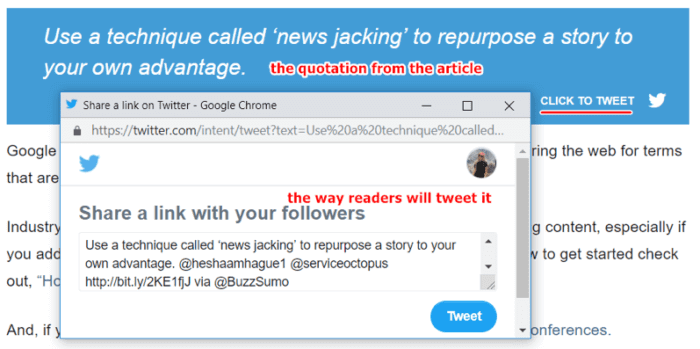
When a person shares the phrase they like from your blog on Twitter, a link to the article will also be included, allowing people to click through to it. Allowing readers to include a quote from your blog means that their tweet about it will be a lot more engaging and likely tailored to their audience, meaning it is likely to perform better.
Discover your audience’s opinion on the issue
Although blog comments can provide insight into your audience’s thoughts on the topic you’ve written about, they are often just empty (as very few people express their opinion there) or contain too much spam.
Social media accounts are useful not only for sharing your recent posts there, but they should also become channels where you talk to your audience. No analytics and statistics will tell you more about your followers than your followers themselves.
Create Facebook polls, Twitter chats, or Instagram Story Polls to find out what your audience likes most about your existing strategy and how they’d like to change your brand. It’s also a great way to come up with content ideas, as you can ask directly what kind of posts engage them best.
Here are some examples of how successful brands interact with their audience:
- A great case of the interaction between content and social media marketing is presented by Social media examiner. It holds a weekly TweetChat, which you can find out about from the brand’s blog, so people know to head to their social profile.

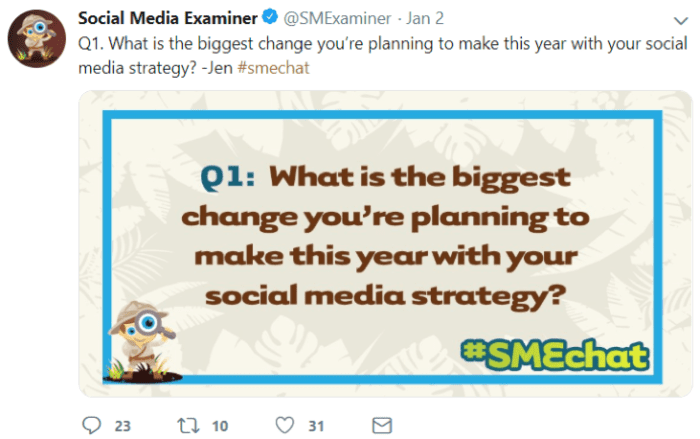
- Sepstat uses polls to ask its followers for information that matters to its prospects, enabling the brand to focus on developing the tools that matter to its followers.
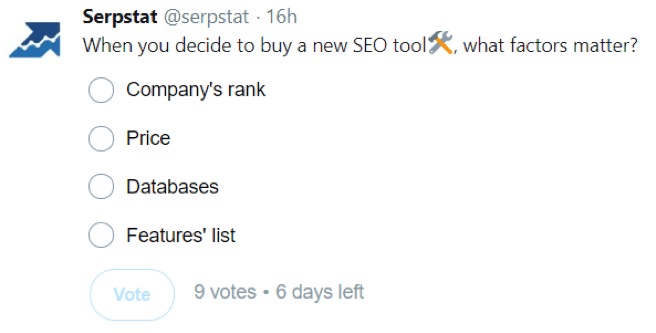
- Benefit asks its customers about their preferences on what they’d like to find out from their weekly tutorials. This is an excellent example of how brands can communicate with their customers in order to make content that is both relevant and targeted.

Personal branding is king
It’s great that you can find out what your audience thinks, but it’s also essential for them to hear your opinion. Building transparency and credibility is one of the most important steps for every company.
Communicating with your prospects means more than simply asking them at the end of your posts something like: ‘What do you think on the latest SEO trends? Share your opinion in the comments’, and then never checking their answers. It means being ready to respond and showing you’re always there to share your opinion with them or answer their questions.
If you want your prospects to trust you, don’t hide behind your company name. Brands that post content created by no-name employees, send emails signing with the company name, etc., miss the opportunity to build a personal connection with their audience.
Unless you represent Apple or Amazon, make sure your visitors know who stands behind your brand. Once you encourage your employees to build personal brands, you not only make your marketing personalized, but you also get more channels to promote your company.
Here’s a short list of the most crucial tactics on your way to building strong relationships with your audience:
- When you post new articles, don’t forget to give the author’s bio with a link to their Twitter or LinkedIn account for readers to see who’s working in your team.
- Give your writers a ‘task’ to stay active on their social media accounts and search for customer reviews on your products to respond to all the concerns as soon as possible.
- Don’t limit your content marketing to your blog. Livestream on Instagram, provide academies with educational content for you to show you have great expertise to share it with your audience.
Add engaging features into your blog posts
Yes, you know that sharing your blog content on social media channels is an efficient way to promote it. But did you notice it’s pretty difficult to attract users’ attention on social media?
When they’re scrolling through their feed, they aren’t ready to read every article they find there. As all the brands that have mastered content marketing use their accounts to promote new topics, your followers’ feed is often crowded with similar content. As a result, they may not only skip it but get irritated with your brand.
However, it doesn’t mean you shouldn’t share your content. You should. Just make it stand out. Memes, gifs, videos, everything that will attract your followers’ attention, at least for a minute, will increase the chance that they’ll read your title and decide it’s worth reading.
Tom Fishburne is a marketer who teams his articles with awesome cartoons illustrating the topics he writes about. Once you see the cartoon, you can’t help but follow the link to read the whole post. The high engagement, therefore, isn’t surprising.
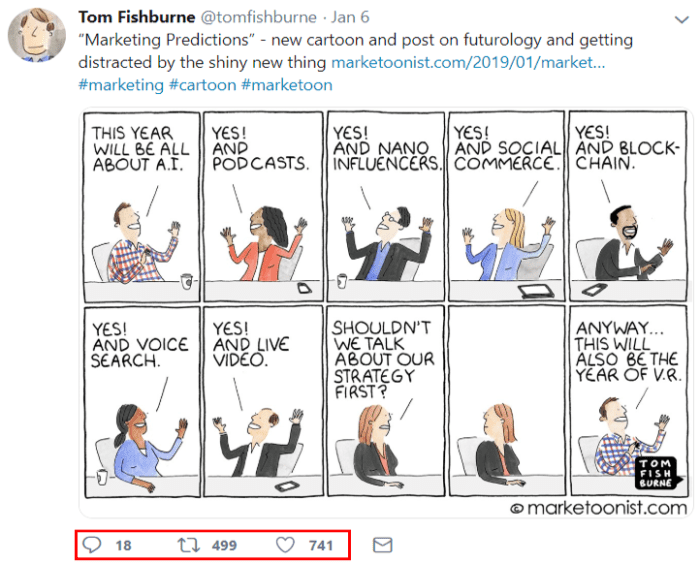
You may say ‘He has 31.4K followers, of course, the high engagement isn’t surprising.’ But let’s look at his tweet with a link to Tom’s new TED talk.
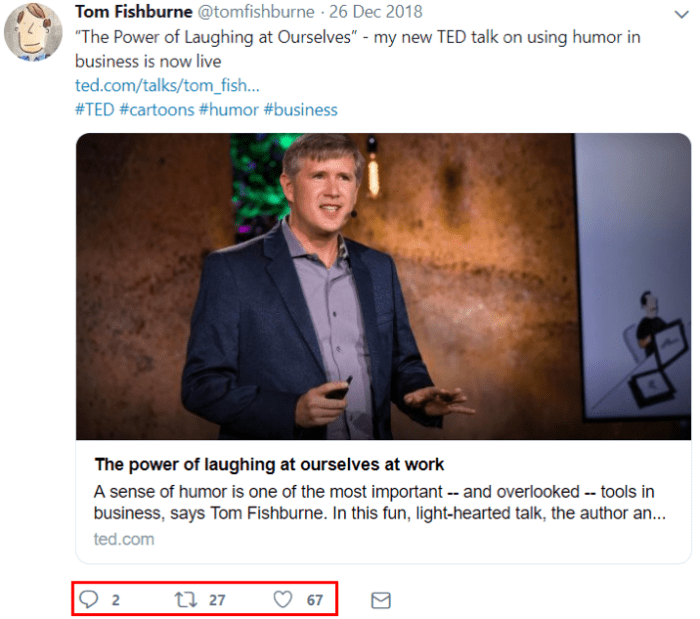
There is a big difference in engagement, which could be a result of the cartoons capturing a lot more interest.
Identify your best performing content
This tip is the most obvious, but I still think it’s worth reminding you of its importance. Tracking the number of social shares on Facebook, LinkedIn, or Twitter lets marketers see what kind of content engages social media users the most. Such data will help you come up with topics you should dwell on to get even better results.
The best part of it is that you can track both your own results and your competitors’ engagement to see how users interact with specific content even before you post it. Discover competitors’ best performing content to develop their ideas and implement them into your content planning.
Services such as Buzzsumo will let you analyze website content social performance. Enter the site into the search field, click on Search, and the service will provide you with all the articles sorted by total engagements:

This means you can emulate competitors’ content that is high performing and seek to improve the content on your site that is not performing.
Your keywords = your hashtags
If you already mastered content marketing, then you know that proper keyword research is one of the crucial steps on your way to high rankings. Selecting the right keywords and knowing how to add them to your content will help it rank for the relevant queries.
What’s most important is that your choice should depend on the niche you are writing about, the competition level and your site’s authority. It means that if niche giants and small businesses tried to rank for the same keywords, the result would be pretty predictable.
Moreover, proper keyword research will not only improve your search positions but also will help you choose the right hashtags for your social media posts. Can’t you just add #SEO hashtag when writing about SEO issues? You can. But it will be useless. The more general word you use, the more posts using it there will be appearing every second. So, your one will stay unnoticed in the bowels of archives.
To both rank high and use the right hashtags, you should learn how to research keywords, long-tail keywords, to be more precise. Go to Serpstat > enter the word or the phrase best describing your topic > choose search engine > click on Search > go to SEO Research > Keyword Selection. There you’ll see the list of the phrases containing your keyword. You can filter the list by the number of words in a keyword, by search volume, exclude misspelled words, etc.
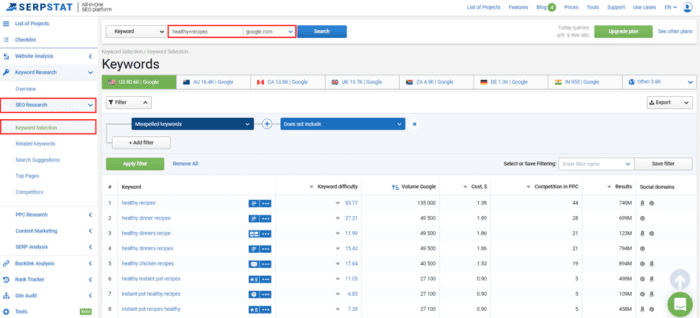
After you’ve selected the keywords for your content, check hashtags using these phrases. Are they too popular or not used at all? I’ve checked the second phrase from the list and entered #HealthyDinnerRecipes into the search field. The result met my expectations. The hashtag isn’t spammy, all the posts are relevant to the subject, and if someone searches for this hashtag, he or she will definitely see my recent post on the topic.

Check in the same way all the phrases you’ve chosen, and don’t forget to add the best hashtags to your posts.
Integrate your content and social media marketing teams
The last but not the least. Your content and social media marketing teams should remember they have common goals. Make sure you have a content schedule for social media marketers to know when they should start promoting your new posts.
You should also provide regular meetings for both teams to ensure they keep the same pace. Discuss plans, sum up, schedule the working process for better collaboration. Always keep your content and social media marketing strategies in alignment.
Final thoughts
Joining up your blog and social media strategies can deliver better engagement and help you improve the content you are producing. In addition to this, it helps to deliver a cohesive brand experience, especially if your teams are working together to create the strategy.
By Expert commentator
This is a post we’ve invited from a digital marketing specialist who has agreed to share their expertise, opinions and case studies. Their details are given at the end of the article.





